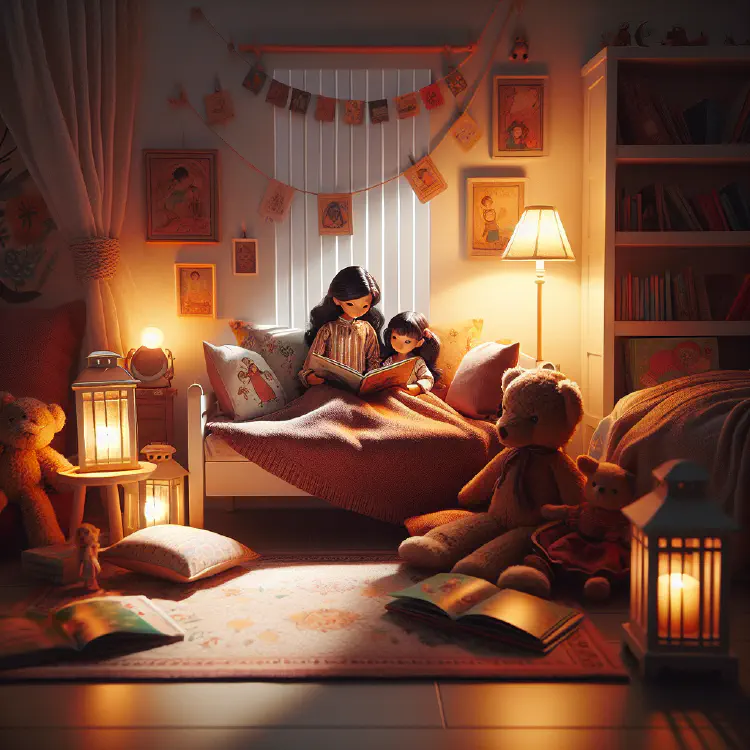Bedtime Stories That Help Kids Feel Safe and Loved
Bedtime stories create bonding time, boost language skills and imagination, promote emotional intelligence, aid relaxation, and establish routines for children's sleep.
- 3 min read

As parents, we all know the importance of a good night’s sleep for our little ones. But sometimes, getting children to settle down and drift off to dreamland can be a challenge. That’s where bedtime stories come in. These magical tales not only help kids wind down after a busy day but also provide a sense of comfort, security, and love that can last long after the lights go out.
In this blog post, we’ll explore the world of bedtime stories and how they can help your children feel safe and loved as they drift off to sleep. We’ll discuss the benefits of storytelling at bedtime, offer tips for creating a cozy storytelling environment, and share some of our favorite bedtime stories for kids of all ages.
The Power of Bedtime Stories
Bedtime stories have been a cherished tradition for generations, and for good reason. These nightly tales offer numerous benefits for both children and parents:
Bonding time: Reading bedtime stories creates a special moment for parents and children to connect and share quality time together.
Language development: Regular exposure to stories helps children expand their vocabulary and improve their language skills.
Imagination boost: Bedtime stories encourage creativity and help children develop their imagination.
Emotional intelligence: Stories often explore different emotions and situations, helping children understand and process their feelings.
Relaxation: The soothing rhythm of a parent’s voice can help children calm down and prepare for sleep.
Establishing routine: A consistent bedtime story routine can signal to children that it’s time to wind down and prepare for sleep.
Creating the Perfect Bedtime Story Environment
To make the most of your bedtime story experience, consider creating a cozy and inviting environment that promotes relaxation and comfort. Here are some tips:
Choose a comfortable spot: Whether it’s snuggled up in bed or curled up in a cozy reading nook, make sure you and your child are comfortable.
Dim the lights: Use soft, warm lighting to create a calming atmosphere. A small bedside lamp or nightlight can work wonders.
Minimize distractions: Turn off screens and put away toys to help your child focus on the story.
Use props: Incorporate soft blankets, stuffed animals, or even puppets to make the storytelling experience more engaging and interactive.
Set a consistent time: Try to start your bedtime story routine at the same time each night to help establish a predictable sleep schedule.
Choosing the Right Bedtime Stories
When selecting bedtime stories for your children, consider their age, interests, and emotional needs. Here are some suggestions for different age groups:
Bedtime Stories for Toddlers (Ages 1-3)
For toddlers, short, simple stories with repetitive phrases and colorful illustrations work best. Look for books that focus on familiar objects, animals, or daily routines. Some popular options include:
- “Goodnight Moon” by Margaret Wise Brown
- “The Going to Bed Book” by Sandra Boynton
- “Time for Bed” by Mem Fox
- “Llama Llama Red Pajama” by Anna Dewdney
- “I Love You, Stinky Face” by Lisa McCourt
Bedtime Stories for Preschoolers (Ages 3-5)
Preschoolers can handle slightly longer stories with more complex plots and characters. Look for books that explore emotions, friendships, and simple life lessons. Some great choices include:
- “The Gruffalo” by Julia Donaldson
- “Where the Wild Things Are” by Maurice Sendak
- “The Kissing Hand” by Audrey Penn
- “How to Catch a Star” by Oliver Jeffers
- “The Invisible String” by Patrice Karst
Bedtime Stories for Early Elementary (Ages 6-8)
As children grow older, they can enjoy chapter books or longer picture books with more intricate storylines. Consider stories that spark imagination and encourage empathy. Some popular options include:
- “Charlotte’s Web” by E.B. White
- “The BFG” by Roald Dahl
- “The Tale of Despereaux” by Kate DiCamillo
- “The Wonderful Wizard of Oz” by L. Frank Baum
- “The Lion, the Witch and the
